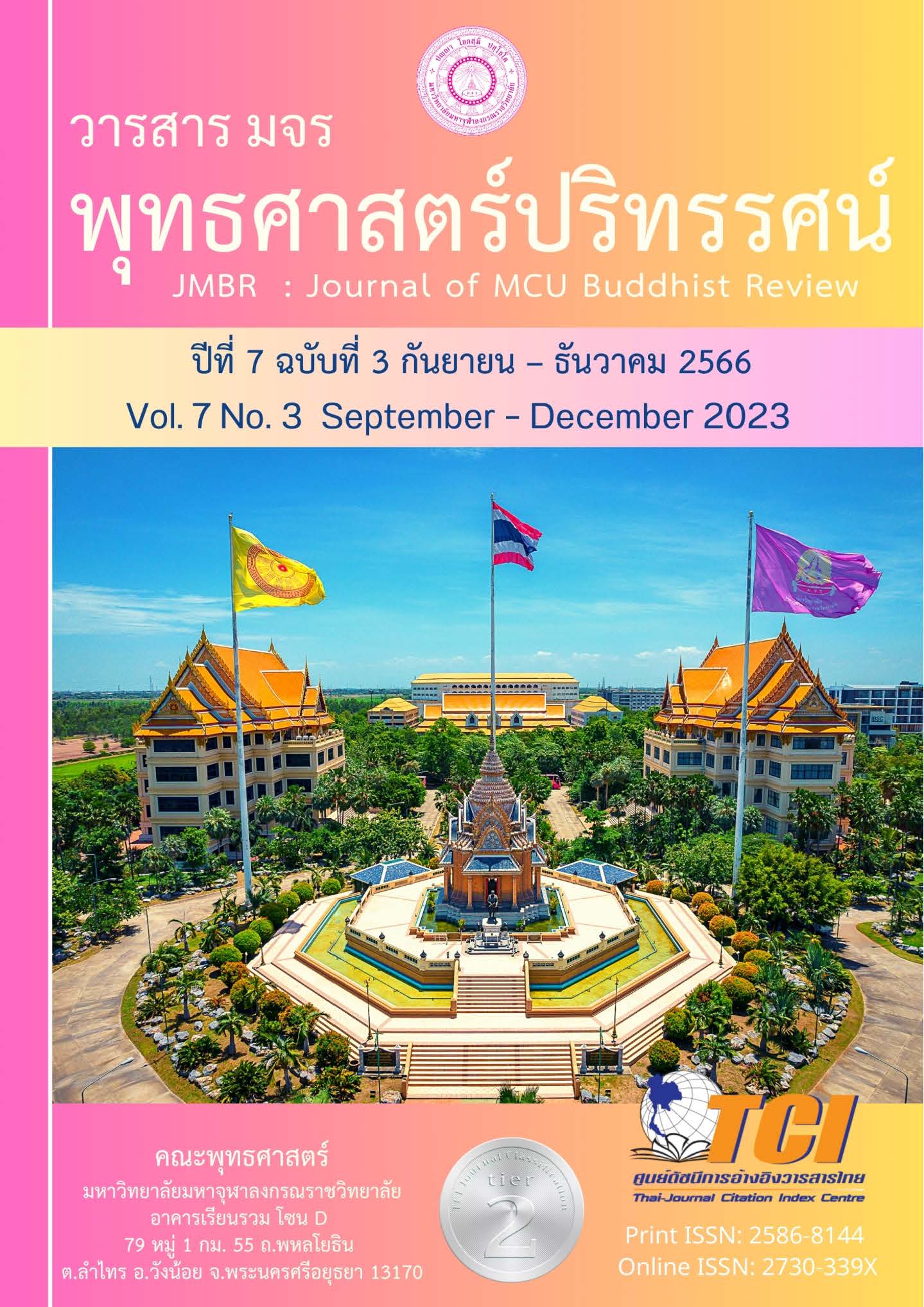วิเคราะห์องค์คุณการเป็นอริยบุคคลในวัตถูปมสูตร
Main Article Content
บทคัดย่อ
บทความวิจัยนี้มีวัตถุประสงค์ 1) เพื่อศึกษาโครงสร้าง และสาระสำคัญในวัตถูปมสูตร 2) เพื่อศึกษาองค์คุณการบรรลุธรรมเป็นอริยบุคคลในวัตถูปมสูตร 3) เพื่อวิเคราะห์คุณค่าการเป็นอริยบุคคลในวัตถูปมสูตร เป็นการวิจัยเชิงเอกสาร แหล่งข้อมูลจากพระไตรปิฎก อรรถกถา หนังสือและงานวิจัย วิเคราะห์ข้อมูลและนำเสนอผลวิจัยเชิงพรรณนา
ผลการวิจัยพบว่า 1) วัตถูปมสูตรปรากฏในโครงสร้างพระไตรปิฎก เป็นพระสูตรว่าด้วยข้ออุปมาด้วยผ้าสาระสำคัญระบุอุปกิเลส 16 ชนิดเป็นอุปสรรคขัดขวางจิตไม่ให้พัฒนา จึงอุปมาจิตมีอุปกิเลสเสมือนผ้าสกปรกนำไปย้อม กับจิตบริสุทธิ์เสมือนผ้าสะอาดนำไปย้อม ผลที่ได้มีความแตกต่าง เมื่อจิตมีอุปกิเลส จึงต้องรู้ชัด เพียรละแล้วเกิดความเลื่อมใสแน่วแน่ในพระรัตนตรัย สลัดทิ้ง จิตตั้งมั่น ปฏิบัติตนดำรงอยู่ไม่ขัดต่อมรรค แผ่พรหมวิหารธรรมไปทั่วทิศ เกิดมีวิชชารู้ทั่วดับอวิชชา ชั้นอริยบุคคล 4 จำพวก 8 บุคคลจนหลุดพ้นทุกข์ 2) องค์คุณเป็นเครื่องมือในการปฏิบัติพัฒนาให้เป็นอริยบุคคล สติปัฏฐาน 4 ทำหน้าที่เพื่อความรู้ชัด ไตรสิกขา ทำความถึงพร้อมด้วยศีล สมาธิ ปัญญาให้สมบูรณ์บริสุทธิ์ ขัดเกลากิเลสโดยเจริญฌานเพื่อข่มกิเลสให้สงบ รวมจิตเป็นหนึ่งเดียวเกิดฌาน 1-4 เป็นฐาน ยกจิตขึ้นสู่วิปัสสนาภาวนา ใช้มรรคในอริยบุคคลดับอุปกิเลส 16 3) ก่อเกิดคุณค่าความเป็นอริยบุคคล คือ เมื่อปฏิบัติตามจะพัฒนายกจิตปุถุชนให้เป็นผู้มีจิตใจสูง จากการปรับเปลี่ยนพฤติกรรมไม่ดีทำเคยชินเป็นนิสัยให้เกิดความบริสุทธิ์ เป็นฐานต่อให้การพัฒนาด้านการปฏิบัติภาวนาขั้นสูง มีสมถภาวนาเป็นฐาน ทำให้แจ้งด้วยวิปัสสนาภาวนา นำอุปกิเลสออกจากกมลสันดานที่ฝังลึกในจิต ใช้ภาวนามยปัญญาจัดการทำให้มีปัญญาสมบูรณ์วิชชาเกิดขึ้น ทำลายอวิชชาดับสูญไป นำไปสู่คุณค่าทางปัญญาของอริยบุคคล ผู้ที่ได้ชื่อว่าเป็นอริยบุคคล จึงเกิดจากการรู้จักอุปกิเลส รู้จักควบคุม รู้วิธีสลัดทิ้ง รู้วิธีละอุปกิเลสในจิตตนเอง
Article Details

อนุญาตภายใต้เงื่อนไข Creative Commons Attribution-NonCommercial-NoDerivatives 4.0 International License.
- บทความที่ได้รับการตีพิมพ์เป็นลิขสิทธิ์ของวารสาร มจร พุทธศาสตร์ปริทรรศน์
- ข้อความใดๆ ที่ปรากฎในบทความที่ได้รับการตีพิมพ์ในวารสาร ถือเป็นความรับผิดชอบของผู้เขียนบทความ และข้อคิดเห็นนั้นไม่ถือว่าเป็นทัศนะและความรับผิดชอบของกองบรรณาธิการวารสาร มจร พุทธศาสตร์ปริทรรศน์
เอกสารอ้างอิง
ไทยออนทัวร์. (27 กุมภาพันธ์ 2563). แม่น้ำคงคา (Ganges River) เมืองพาราณสี ประเทศอินเดีย. สืบค้น 29 สิงหาคม 2566 จาก https://thaiontours.com/india/ganges-river-india.
นะโมพุทธายะ. (11 กันยายน 2558). เจริญพรหมวิหาร 4 ควบคุมอำนาจกสิณ. สืบค้น 29 สิงหาคม 2566 จาก https://palungjit.org/threads/เจริญพรหมวิหาร4-ควบคุมอำนาจกสิณ.554954/.
พระติปิฎกจูฬาภยเถระ. (2559). คัมภีร์มิลินทปัญหาภาษาไทย. กรุงเทพฯ: โรงพิมพ์มหาจุฬาลงกรณราชวิทยาลัย.
พระพรหมคุณาภรณ์ (ป.อ. ปยุตฺโต) (2559). พจนานุกรมพุทธศาสน์ ฉบับประมวลธรรม. พิมพ์ครั้งที่ 34. กรุงเทพฯ: โรงพิมพ์พระพุทธศาสนาของธรรมสภา.
พระพรหมคุณาภรณ์ (ป.อ. ปยุตฺโต) (2559). พจนานุกรรมพุทธศาสน์ ฉบับประมวลศัพท์, พิมพ์ครั้งที่ 27. กรุงเทพฯ: โรงพิมพ์มหาจุฬาลงกรณราชวิทยาลัย.
พระพุทธโฆสเถระ. (2555). คัมภีร์วิสุทธิมรรคภาษาไทย. กรุงเทพฯ: โรงพิมพ์มหาจุฬาลงกรณราชวิทยาลัย.
พระมงคลธรรมวิธาน. (2562). ธรรมกับการดำเนินชีวิตในยุคประเทศไทย 4.0. วารสารวิชาการโรงเรียนนายเรือ ด้านสังคมศาสตร์ มนุษยศาสตร์ และศึกษาศาสตร์. 6(1), 53-61.
พระมหาเอกชัย อุปวฑฺฒโน (ข่อยแก้ว). (2566). ศึกษาวิเคราะห์ธรรมาภิสมัยของพระอริยบุคคลตามหลักไตรสิกขา. วารสารมหาจุฬาวิชาการ. 10 (1), 348-362.
พระวุฒิไกร สิริสาโร (ตาไธสง) . (2561). ศึกษาประโยชน์ 3 ที่มีผลต่อการเจริญวิปัสสนาภาวนา. วิทยานิพนธ์พุทธศาสตรมหาบัณฑิต บัณฑิตวิทยาลัย: มหาวิทยาลัยมหาจุฬาลงกรณราชวิทยาลัย.
พุทธทาสภิกขุ. (2554). คู่มือที่จำเป็นในการศึกษาและปฏิบัติธรรม. พิมพ์ครั้งที่ 2. กรุงเทพฯ: ธรรมสภา.
มติชนออนไลน์. (18 มกราคม 2556). ผลวิจัยล่าสุดยืนยันพิธีอาบน้ำ “กุมภะเมลา” ในอินเดีย “ดีต่อสุขภาพ”. สืบค้น 29 สิงหาคม 2566 จาก https://mgronline.com/around/detail/9560000007202
มหาจุฬาลงกรณราชวิทยาลัย. (2539). พระไตรปิฎกภาษาไทย ฉบับมหาจุฬาลงกรณราชวิทยาลัย. กรุงเทพฯ: มหาจุฬาลงกรณราชวิทยาลัย.
สุชาดา ทองมาลัย. (2561). วิเคราะห์ความสัมพันธ์ของการปฏิบัติสมถภาวนาและวิปัสสนาภาวนาต่อการบรรลุธรรม. วารสารมนุษยศาสตร์. 25(2), 376-409.


